Found footage and the gothic conventions
DOI:
https://doi.org/10.12957/soletras.2014.11121Palavras-chave:
Literatura gótica, reivindicação da veracidade, filmes de horror, found footageResumo
Social, historical, political and economic changes somehow are invariably reflected in the cultural and artistic manifestations of their time. In Gothic literature this is noticeable in elements such as medieval settings when they were more frequent (The Castle of Otranto), or the questionings regarding the creationist thought suggested in Frankenstein, materialized in The Origin of Species and revisited in The Strange Case of Dr. Jekyll and Mr. Hyde and Dracula, works that also display the technicism and scientific advancements in the second phase of the Industrial Revolution. Nonetheless, one recurrent element in the literary Gothic convention regardless of its time is the claims to truthfulness, understood here as an effort to convince the reader/viewer that the story told indeed happened, as incredible as it seems. Therefore, this article verifies the ways in which the claims to truthfulness appear in found footage movies, observing how the classical Gothic characteristics are replicated or subverted in this subgenre of horror movies. The conclusion points out that convincing the reader/viewer that the story is real still is a priority in the Gothic agenda. The theoretical support comes from texts present in seminal companions to the Gothic (Hogle, 2002; Punter, 2006; Botting, 2004), from Jenkins (2009), through the notion of convergence culture, from Baudrillard (2002), through the notion of the three postmodern phantasies, and from Aufdenheide (2007), through the concept of claims to truthfulness.Downloads
Publicado
Edição
Seção
Licença
A aprovação dos artigos implica a cessão imediata e sem ônus dos direitos de publicação nesta revista. O(s) autor(es) autoriza(m) ao Programa de Pós-graduação em Letras e Linguística (PPLIN) a reproduzi-lo e publicá-lo na revista SOLETRAS, entendendo-se os termos “reprodução” e “publicação” conforme definição do artigo 5° da Lei 9610/98. O(s) autor(es) continuará(rão) a ter os direitos autorais para publicações posteriores. O artigo poderá ser acessado pela rede mundial de computadores (http://www.e-publicacoes.uerj.br/index.php/soletras), sendo permitidas, a título gratuito, a consulta e a reprodução de exemplar do artigo para uso próprio de quem o consulta. Casos de plágio ou quaisquer ilegalidades nos textos apresentados são de inteira responsabilidade de seus autores.



